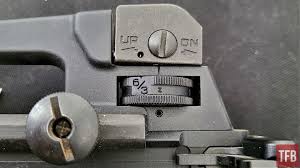The 6/3 a2 rear sight 50/200 zero is one of the most iconic and reliable sighting systems ever issued on AR-15 and M16 platforms. Designed for precision and durability, it offers a versatile range of adjustments for both windage and elevation. When paired with the 50/200 zero, it becomes an incredibly effective setup for both civilian shooters and military personnel, offering speed, simplicity, and practical accuracy out to extended ranges.
1. Understanding the 6/3 A2 Rear Sight System
The 6/3 designation refers to the sight’s elevation drum, which is marked for ranges from 300 to 600 meters. On many detachable carry handle sights, this drum is designed for use with military ballistics data for 5.56 NATO ammunition.
Unlike more modern optics, the A2 rear sight uses a robust mechanical system that is less susceptible to battery failure, weather, or shock. It provides two apertures—one large for close or low-light shooting and one small for precision daylight shooting—allowing the shooter to adapt to different situations instantly.
The system’s combination of mechanical durability and fine adjustability makes it ideal for those who want a zero that holds steady over time.
2. The Concept of the 50/200 Zero
The 50/200 zero is a ballistic concept in which your rifle’s point of impact at 50 yards is the same as it is at approximately 200 yards. This is due to the way a bullet’s trajectory arcs through space, intersecting the shooter’s line of sight twice.
2.1 Ballistic Principles Behind the 50/200 Zero
When a bullet leaves the barrel, it begins to drop due to gravity, but because the barrel is angled slightly upward relative to the line of sight, the bullet initially rises, crosses the sight line around 50 yards, reaches its maximum height somewhere around 150 yards, and then drops back down to intersect again at 200 yards.
This setup minimizes the need for constant elevation changes within common engagement distances.
2.2 Advantages in Real-World Shooting
- Minimal holdover from 0 to 250 yards
- Quick target engagement without needing to adjust sights or reticles
- Reduced complexity for defensive or competition shooting
- Works well for both CQB and mid-range scenarios
2.3 Limitations to Consider
- Bullet drop becomes significant past 250 yards
- Different ammunition types may shift the zero slightly
- Environmental factors like wind and elevation can still affect accuracy
3. How to Set Up a 6/3 A2 Rear Sight for a 50/200 Zero
Zeroing your 6/3 A2 rear sight for the 50/200 setup involves both mechanical preparation and live-fire confirmation.
3.1 Mechanical Zeroing Procedure
- Set the elevation drum to 6/3 and rotate it one click down from the marked “3” setting.
- Center the rear sight windage knob by counting clicks from one extreme to the other and dividing by two.
- Ensure the front sight post is at its standard height from the factory (flush with the front sight base).
3.2 Live-Fire Zeroing at 50 Yards
- Use a stable shooting position such as prone with sandbags.
- Fire a 3- to 5-shot group at the center of your target at 50 yards.
- Adjust windage using the rear sight knob and elevation using the front sight post.
- Repeat until your group impacts dead center.
3.3 Verifying at 200 Yards
- Move to a 200-yard target.
- Fire another group to confirm that your point of aim and point of impact match.
- If there is a slight deviation, make minimal adjustments—preferably with the front sight post for elevation.
4. Fine-Tuning and Maintenance for Consistency
Even with a perfect zero, sights can shift over time due to handling, recoil, or environmental effects.
4.1 Windage and Elevation Adjustments
Keep a record of your zero settings so you can quickly return to them if they’re changed. Make note of ammunition type, range conditions, and click counts.
4.2 Regular Inspection and Cleaning
- Clean the sight apertures and adjustment knobs.
- Apply light oil to prevent rust.
- Check that the sight base screws are snug but not over-tightened.
4.3 Troubleshooting Common Zero Issues
- Impact too high or low: Adjust front sight post height.
- Lateral deviation: Check windage knob and ensure it hasn’t shifted.
- Inconsistent grouping: Verify ammo consistency and shooter fundamentals.
5. Practical Applications and Training with a 50/200 Zero
Once your rifle is set up, the 50/200 zero provides real benefits in training and real-world application:
- Home Defense: Quick engagement without complex aiming adjustments.
- Competition: Faster follow-up shots with predictable impact points.
- Military/LE: Reliable in variable distances without constant sight manipulation.
Regular practice at both 50 and 200 yards will help you trust your zero, develop confidence, and understand your rifle’s capabilities at intermediate distances.
